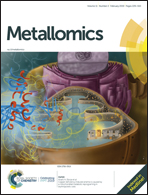A gonadotropin-releasing hormone type neuropeptide with a high affinity binding site for copper(ii) and nickel(ii)
Abstract
In vertebrates gonadotropin-releasing hormone I (GnRH-I) is a key regulator of reproductive development and function. The receptor-binding activity of human GnRH-I can be modified by the presence of divalent copper. Thus, copper binding to N-terminal amino acids in GnRH-I induces structural changes that influence receptor interactions and downstream intracellular signalling cascades. It is not known if copper-binding is restricted to human GnRH-I or if it is also a feature of GnRH-type peptides that have been identified in other taxa. To investigate this, we have characterised copper binding to a recently discovered GnRH-type peptide from the starfish Asterias rubens (ArGnRH). Using a range of spectroscopic and biophysical techniques we show that this peptide can bind copper(II) and nickel(II). Copper(II) is bound in a square-planar, high-affinity (Kd ∼ 10−12 M) site incorporating four nitrogen donor atoms from a histidine imidazole group, two amides and the N-terminal amine group. The ArGnRH copper affinity and geometry are quite different to GnRH-I suggesting the copper sites have evolved to suit the environment the peptides are exposed to. By comparing the copper binding sites in ArGnRH and human GnRH-I and conducting a phylogenetic analysis of GnRH-type peptide sequences from a range of species, we predict that copper-binding is an evolutionarily ancient feature of GnRH-type peptides that has been retained, modified or lost in different lineages.



 Please wait while we load your content...
Please wait while we load your content...